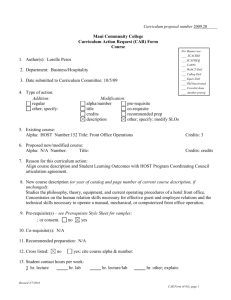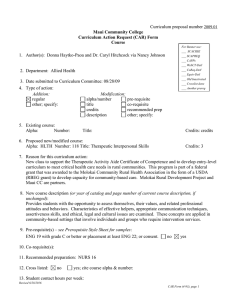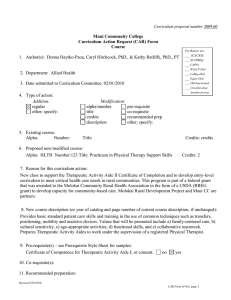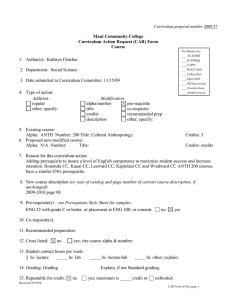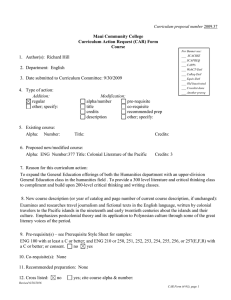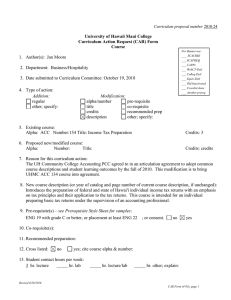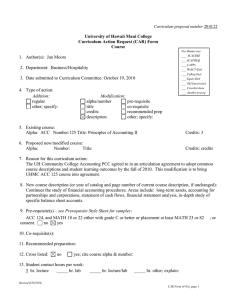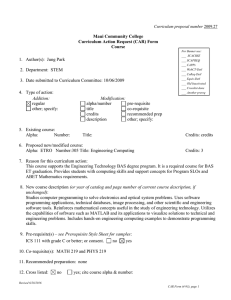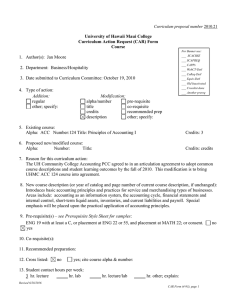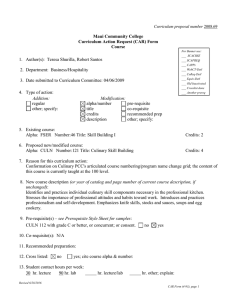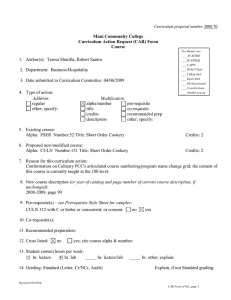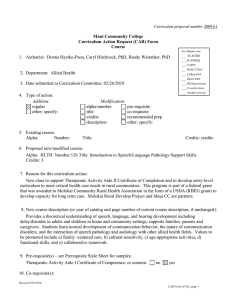Maui Community College Curriculum Action Request (CAR) Form Course
advertisement
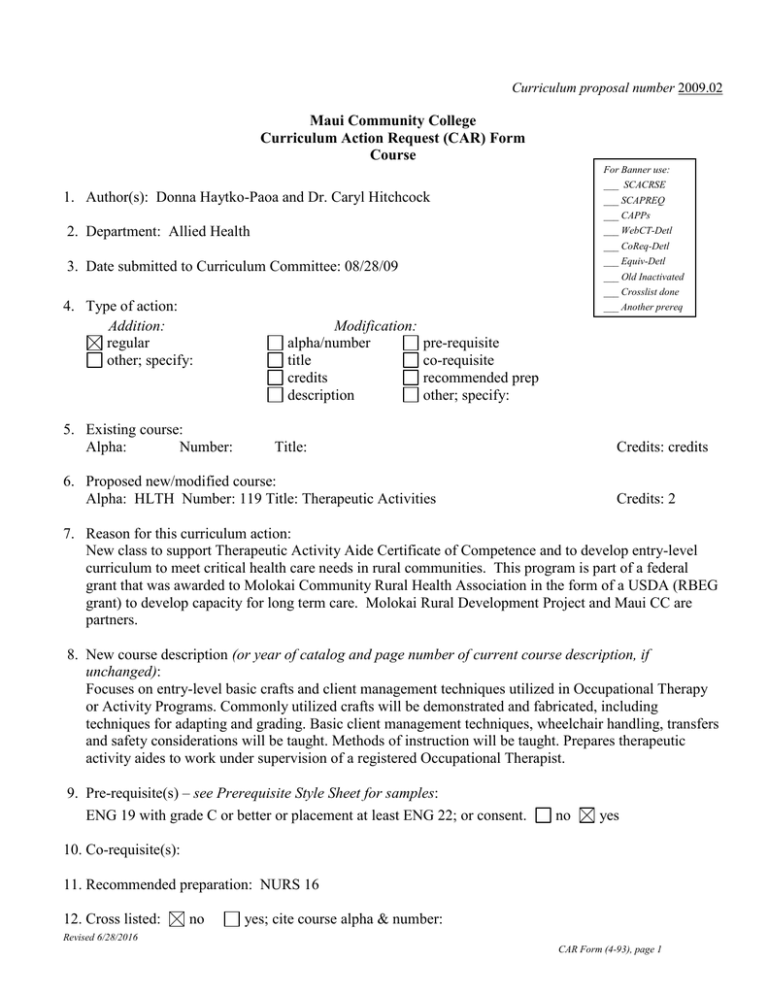
Curriculum proposal number 2009.02 Maui Community College Curriculum Action Request (CAR) Form Course For Banner use: ___ SCACRSE 1. Author(s): Donna Haytko-Paoa and Dr. Caryl Hitchcock ___ SCAPREQ ___ CAPPs 2. Department: Allied Health ___ WebCT-Detl ___ CoReq-Detl ___ Equiv-Detl 3. Date submitted to Curriculum Committee: 08/28/09 ___ Old Inactivated ___ Crosslist done 4. Type of action: Addition: regular other; specify: 5. Existing course: Alpha: Number: ___ Another prereq Modification: alpha/number title credits description pre-requisite co-requisite recommended prep other; specify: Title: Credits: credits 6. Proposed new/modified course: Alpha: HLTH Number: 119 Title: Therapeutic Activities Credits: 2 7. Reason for this curriculum action: New class to support Therapeutic Activity Aide Certificate of Competence and to develop entry-level curriculum to meet critical health care needs in rural communities. This program is part of a federal grant that was awarded to Molokai Community Rural Health Association in the form of a USDA (RBEG grant) to develop capacity for long term care. Molokai Rural Development Project and Maui CC are partners. 8. New course description (or year of catalog and page number of current course description, if unchanged): Focuses on entry-level basic crafts and client management techniques utilized in Occupational Therapy or Activity Programs. Commonly utilized crafts will be demonstrated and fabricated, including techniques for adapting and grading. Basic client management techniques, wheelchair handling, transfers and safety considerations will be taught. Methods of instruction will be taught. Prepares therapeutic activity aides to work under supervision of a registered Occupational Therapist. 9. Pre-requisite(s) – see Prerequisite Style Sheet for samples: ENG 19 with grade C or better or placement at least ENG 22; or consent. no yes 10. Co-requisite(s): 11. Recommended preparation: NURS 16 12. Cross listed: no yes; cite course alpha & number: Revised 6/28/2016 CAR Form (4-93), page 1 13. Student contact hours per week: hr. lecture hr. lab 4 hr. lecture/lab hr. other; explain: 14. Grading: Letter grade only/No Audit Explain, if not Standard grading: Certificiate of Competence requires letter grades so that students must earn a 2.0 GPA or higher in all credit courses to earn the certificate. 15. Repeatable for credit: no yes; maximum is credit or unlimited. (Most courses are not repeatable for additional credit; exceptions are courses such as internships and co-op courses.) 16. Special fees required: no yes; explain: Allied Health course malapractice insurance fee 17. Proposed term of first offering: Fall semester of 2010 year. 18. List catalog used and then degrees, certificates, prerequisites, and catalog sections and their page numbers affected by this proposal: 22. 28. 114 19. Maximum enrollment: 16 Rationale, if less than 35: Lecture/lab setting requires hands-on learning activities and more intensive supervision. 20. Special resources (personnel, supplies, etc.) required: purchased supplies no yes; explain: Grant built facility and 21. Course is restricted to particular room type: no yes; explain: lecture/lab setting 22. Special scheduling considerations: no yes; explain: 23. Method(s) of delivery appropriate for this course: (check all that apply) Traditional HITS/Interactive TV Cable TV Online Other, explain: Hybrid 24. Mark all college-wide general education SLOs this course supports. Std 1 - Written Communications Std 2 – Quantitative Reasoning Std 3 - Information Retrieval and Technology Std 4 - Oral Communication Std 5 - Critical Reasoning Std 6 – Creativity Other General Education SLOs, such as Ethics, Scientific Inquiry, or Service Learning. Explain: 25. List all program SLOs this course supports? (Explain, if necessary) Program SLO 1: Program SLO 2: Program SLO 3: Program SLO 4: Program SLO 5: Explain: Explain: Explain: Explain: Explain: Revised 6/28/2016 CAR Form (4-93), page 2 26. Course fulfills the following general education elective (GE) for CTE (Career Technical Education) AS/AAS degrees (GE): English (EN)/Communication (CM) Quantitative Reasoning (QR) Humanities (HU) Natural Science (NS) Social Science (SS) Other: Course is a requirement for the program(s) AS/AAS degree or certificate Course is a program elective for the program(s) AS/AAS degree or certificate 27. Course fulfills the following general education elective (GE) for the ABIT BAS degree: English (EN)/Communication (CM) Quantitative Reasoning (QR) Humanities (HU) Natural Science (NS) Social Science (SS) Other: Course is a requirement for the ABIT BAS degree Course is a program elective for the ABIT BAS degree 28. Course fulfills a requirement for a proposed BAS degree: Pre- requisite course Core Capstone Course (CC) Other: Course is a program elective for a proposed BAS degree Course fulfills the following general education elective (GE) for the proposed BAS English (EN)/Communication (CM) Quantitative Reasoning (QR) Humanities (HU) Natural Science (NS) Social Science (SS) Other: Course is applicable to the following additional BAS degrees: 29. degree: Course satisfies the following category for the AA degree*: Category I: Foundations/Skills: Foundations I Written Communication in English (FW) Global and Multicultural Perspectives (FG) Group A (before 1500 CE) Group B (since 1500 CE) Group C (pre-history to present) Symbolic Reasoning (FS) Category I: Foundations/Skills: Foundations II Numeracy (FN) Oral Communication in English (FO) Computer/Information Processing and Retrieval (FI) Category II: Breadth of Understanding and Experience Human Understanding The Individual (IN) The Community (CO) The Community – Global Perspective (CG) Human Expression (HE) Environmental Awareness (EA) Environmental Awareness – Global Perspective (EG) Asia/Pacific Perspective (AP) Revised 6/28/2016 CAR Form (4-93), page 3 Category III Focus/Specialization/Area of Interest Interest Area Discipline/Alpha: Elective (LE) Other Graduation Requirements Writing Intensive (is appropriate for WI) Environmental Awareness Lab/course with lab (EL) Hawaii Emphasis (HI) * Submit the appropriate form(s) to have the course placed in the requested category (ies). Submit a course outline, CAR, and appropriate forms to both the Curriculum Committee and the Foundations Board, if the course satisfies Category I: Foundations/Skills: Foundations I or II. 30. Course increases decreases makes no change to number of credits required for program(s) affected by this action. Explain, if necessary: 31. Course is taught at another UH campus (see Sections 5 and 6 above): no Explain why this course is proposed for MCC: yes Specify college(s), course, alpha, and number where same or similar course is taught: Similar course, OTA 119, is taught at Kapiolani CC. 32. Course is: Not appropriate for articulation. Appropriate* for articulation as a general education course at: UHCC UH Manoa UH Hilo UHWO Previously articulated* as a general education course at: UHCC UH Manoa UH Hilo UHWO *Note: Submit Course Articulation Form if course is already articulated, or is appropriate for articulation, as a general education (100-, 200-level) course. Standardized and/or appropriate for articulation by PCC or other UH system agreement at: UHCC UH Manoa with KCC and other CCs. UH Hilo UHWO Explain: Possibly appropriate for articulation Appropriate for articulation or has previously been articulated to a specific department or institution: UHCC UH Manoa UH Hilo UHWO Outside UH system Explain: 33. Additional Information (add additional pages if needed): Revised 6/28/2016 CAR Form (4-93), page 4 Maui Community College Curriculum Action Request (CAR) Signature Page __________________________________________________________________________ Proposed by: Author or Program Coordinator Date __________________________________________________________________________ Checked by: Academic Subject Area Representative to Curriculum Committee Date __________________________________________________________________________ Requested by Department: Department Chair Date __________________________________________________________________________ Recommended by: Curriculum Chair Date __________________________________________________________________________ Approved by Academic Senate: Academic Senate Chair Date __________________________________________________________________________ Endorsed by: Chief Academic Officer Date __________________________________________________________________________ Approved by: Chancellor Date Revised 6/28/2016 CAR Form (4-93), page 5 Maui Community College Course Outline 1. Alpha HLTH Number 119 Course Title Therapeutic Activities Credits 2 Department Allied Health Author Donna Haytko-Paoa and Dr.Caryl Hitchcock Date of Outline 08/01/09 2. Course Description: Effective Date Fall 2010 5-year Review Date 2016 Focuses on entry-level basic crafts and client management techniques utilized in Occupational Therapy or Activity Programs. Commonly utilized crafts will be demonstrated and fabricated, including techniques for adapting and grading. Basic client management techniques, wheelchair handling, transfers and safety considerations will be taught. Methods of instruction will be taught. Prepares therapeutic activity aides to work under supervision of a registered Occupational Therapist. Cross-list Contact Hours/Type 3. Pre-requisites 4 hours lecture/lab ENG 19 with grade C or better or placement at ENG 22. Pre-requisite may be waived by consent Co-requisites AS Program no none Recommended Preparation 4. Function/Designation yes Recommended prereq or coreq: NURS 16 AA LE - Elective Category Additional Category List Additional Programs and Category: AAS Program Category List Additional Programs and Category: BAS Program Category List Additional Programs and Category: Developmental/Remedial Other/Additional: Explain: Therapeutic Activity Aide Certificate of Competence See Curriculum Action Request (CAR) form for the college-wide general education student learning outcomes (SLOs) and/or the program learning outcomes (PLOs) this course supports. Revised 6/28/2016 CAR Form (4-93), page 6 This course outline is standardized and/or the result of a community college or system-wide agreement. Responsible committee: 5. Student Learning Outcomes (SLOs): List one to four inclusive SLOs. For assessment, link these to #7 Recommended Course Content, and #9 Recommended Course Requirements & Evaluation. Use roman numerals (I., II., III.) to designate SLOs On successful completion of this course, students will be able to: I. .Demonstrate the fabrication and adaptation of crafts, methods of instruction, and use of occupational therapy techniques to meet individual client needs. II. Demonstrate knowledge of basic client management techniques, wheelchair handling, transfers and safety considerations. III. IV. 6. Competencies/Concepts/Issues/Skills For assessment, link these to #7 Recommended Course Content, and #9 Recommended Course Requirements & Evaluation. Use lower case letters (a., b.…zz. )to designate competencies/skills/issues On successful completion of this course, students will be able to: a. Select and apply direct occupational therapy interventions and procedures to enhance safety, wellness and perfomance in activities of daily living (ADL) , instrumental activities of daily living (IADL), education, work, play, leisure and social participation. b. Grade, adapt and modify the environment, tools, materials, and occupations and interventions to reflect the changing needs of the client and the sociocultural context. c. Use the teaching-learning process and effectively interact through written, oral and nonverbal communication with client, family, and significant others, colleagues, other health providers and the public. d. Educate and train the client, caregiver, family, and significant others to facilitate skills in areas of occupation as well as prevention, health maintenance, and safety in the home and community. e. Use sound judgement in regard to safety of self and others, and adhere to safety regulation throughout the occupational therapy process. f. Fabricate crafts most commonly utilized in Occupational Therapy treatment and activity programs g. Demonstrate therapeutic use of activities through grading, adapting and modifying the environment, tools, materials, and occupations h. Use the teaching-learning process and effectively interact through written, oral and nonverbal communication with client. i. Demonstrate competency in basic client management techniques to enhance mobility, including physical transfers, wheelchair management, and positioning. j. Demonstrate proper maintenance and storage of various materials, equipment, tools and inventory of supplies. Revised 6/28/2016 CAR Form (4-93), page 7 7. Suggested Course Content and Approximate Time Spent on Each Topic Linked to #5. Student Learning Outcomes and # 6 Competencies/Skills/Issues TOPICS/ACTIVITIES 3 Weeks. Safety for client management techniques (II, a, e, i, j) a. Positioning b. Transfers: wheelchair to bed, bed to wheelchair c. Wheelchair handling skills 1 - 2 Weeks Introduction to crafts (I, b, d, i) a. History of crafts in Occupational Therapy b. Therapeutic use of carfts 8 - 9 Weeks Grading and adapting Therapeutic Minor crafts (I, a - j) a. Mosaic tile b. Copper tooling c. Needlework/sewing d. Clay e. Woodworking kits f. Leather kit g. Weaving h. Cultural crafts i. Other current crafts (scrap craft) i. Presentations j. Storing and maintaining inventory, supplies, and equipment 2 - 3 Weeks Application of communication skills & teaching/learning process to activities/games (I, c, d, e, h) a. Group interactions b. Cognitive groups c. Reminiscent groups 8. Text and Materials, Reference Materials, and Auxiliary Materials Appropriate text(s) and materials will be chosen at the time the course is offered from those currently available in the field. Examples include: The text will be chosen at the time the course is to offered from those texts available in the field. An example of a possible text is: Drake, M. (2007). Crafts and Creative Media in Therapy. Thorofare, NJ: Slack Incorporated. Text(s) may be supplemented with appropriate study guide(s). Test(s) may be supplemented with articles and handouts prepared by the instructor. Revised 6/28/2016 CAR Form (4-93), page 8 Appropriate reference materials will be chosen at the time the course is offered from those currently available in the field. Examples include: Magazines, Journals, Websites and other media appropriate to the course. Appropriate auxiliary materials will be chosen at the time the course is offered from those currently available in the field. Examples include: 9. Suggested Course Requirements and Evaluation Linked to #5. Student Learning Outcomes (SLOs) and #6 Competencies/Skills/Issues Specific course requirements are at the discretion of the instructor at the time the course is being offered. Suggested requirements might include, but are not limited to: Activities (I, a - j) Assignments (I, a - j; II, a - j) Projects/Presentations (I, a - j; II, a - j) Other appropriate assessment methods (I, a - j; II, a - j) 50 - 70% 10 - 30% 20 - 30% 0 - 30% 10. Methods of Instruction Instructional methods will vary considerably by instructor. Specific methods are at the discretion of the instructor teaching the course and might include, but are not limited to: lectures and demonstrations, group discussions, student participation, role play, projects, field trips, and other appropriate emerging modalities 11. Assessment of Intended Student Learning Outcomes Standards Grid attached 12. Additional Information: Assessment of Intended Student Learning Outcomes Standards Key: 3 = Major Emphasis: The student is actively involved (uses, reinforces, applies, and evaluated) in the student learning outcomes. The learner outcome is the focus of the class. 2 = Moderate Emphasis: The student uses, reinforces, applies and is evaluated by this learner outcome, but it is not the focus of the class. 1 = Minor Emphasis: The student is provided an opportunity to use, reinforce, and apply this learner outcome, but does not get evaluated on this learner outcome 0 = No Emphasis: The student does not address this learner outcome COURSE Standard 1 - Written Communication Write effectively to convey ideas that meet the needs of specific audiences and purposes. Outcome 1.1 - Use writing to discover and articulate ideas. Outcome 1.2 - Identify and analyze the audience and purpose for any intended communication. Outcome 1.3 - Choose language, style, and organization appropriate to particular purposes and audiences. Outcome 1.4 - Gather information and document sources appropriately. Outcome 1.5 - Express a main idea as a thesis, hypothesis, or other appropriate statement. Outcome 1.6 - Develop a main idea clearly and concisely with appropriate content. HLTH 119 Revised 6/28/2016 CAR Form (4-93), page 9 1 0 0 2 1 1 Outcome 1.7 - Demonstrate a mastery of the conventions of writing, including grammar, spelling, and mechanics. Outcome 1.8 - Demonstrate proficiency in revision and editing. Outcome 1.9 - Develop a personal voice in written communication. Standard 2 - Quantitative Reasoning Synthesize and articulate information using appropriate mathematical methods to solve problems of quantative reasoning accurately and appropriately. Outcome 2.1 - Apply numeric, graphic, and symbolic skills and other forms of quantitative reasoning accurately and appropriately. Outcome 2.2 - Demonstrate mastery of mathematical concepts, skills, and applications, using technology when appropriate. Outcome 2.3 - Communicate clearly and concisely the methods and results of quantitative problem solving. Outcome 2.4 - Formulate and test hypotheses using numerical experimentation. Outcome 2.5 - Define quantitative issues and problems, gather relevant information, analyze that information, and present results. Outcome 2.6 - Assess the validity of statistical conclusions. Standard 3 - Information Retrieval and Technology Access, evaluate, and utilize information effectively, ethically, and responsibly. Outcome 3.1 - Use print and electronic information technology ethically and responsibly. Outcome 3.2 - Demonstrate knowledge of basic vocabulary, concepts, and operations of information retrieval and technology. Outcome 3.3 - Recognize, identify, and define an information need. Outcome 3.4 - Access and retrieve information through print and electronic media, evaluating the accuracy and authenticity of that information. Outcome 3.5 - Create, manage, organize, and communicate information through electronic media. Outcome 3.6 - Recognize changing technologies and make informed choices about their appropriateness and use. Standard 4 - Oral Communication Practice ethical and responsible oral communications appropriately to a variety of audiences and purposes. Outcome 4.1 - Identify and analyze the audience and purpose of any intended communication. Outcome 4.2 - Gather, evaluate, select, and organize information for the communication. Outcome 4.3 - Use language, techniques, and strategies appropriate to the audience and occasion. Outcome 4.4 - Speak clearly and confidently, using the voice, volume, tone, and articulation appropriate to the audience and occasion. Outcome 4.5 - Summarize, analyze, and evaluate oral communications and ask coherent questions as needed. Outcome 4.6 - Use competent oral expression to initiate and sustain discussions. Standard 5 - Critical Thinking Apply critical thinking skills to effectively address the challenges and solve problems. Outcome 5.1 - Identify and state problems, issues, arguments, and questions contained in a body of information. Outcome 5.2 - Identify and analyze assumptions and underlying points of view relating to an issue or problem. Outcome 5.3 - Formulate research questions that require descriptive and explanatory analyses. Outcome 5.4 - Recognize and understand multiple modes of inquiry, including investigative methods based on observation and analysis. Outcome 5.5 - Evaluate a problem, distinguishing between relevant and irrelevant facts, opinions, assumptions, issues, values, and biases through the use of appropriate evidence. Outcome 5.6 - Apply problem-solving techniques and skills, including the rules of logic and logical sequence. 1 0 0 0 0 0 1 0 0 0 1 3 1 2 2 1 1 1 2 2 2 1 1 1 2 0 2 Outcome 5.8 - Communicate clearly and concisely the methods and results of logical reasoning. 2 1 0 1 Outcome 5.9 - Reflect upon and evaluate their thought processes, value system, and world views in comparison to those of others. 2 Outcome 5.7 - Synthesize information from various sources, drawing appropriate conclusions. Standard 6 - Creativity Revised 6/28/2016 CAR Form (4-93), page 10 Able to express originality through a variety of forms. Outcome 6.1: Generate responses to problems and challenges through intuition and non-linear thinking. Outcome 6.2: Explore diverse approaches to solving a problem or addressing a challenge. Outcome 6.3: Sustain engagement in activities without a preconceived purpose. Outcome 6.4: Apply creative principles to discover and express new ideas. Outcome 6.5: Demonstrate the ability to trust and follow one’s instincts in the absence of external direction Outcome 6.6: Build upon or adapt the ideas of others to create novel expressions or new solutions. Revised 6/28/2016 CAR Form (4-93), page 11 1 2 0 2 0 2
